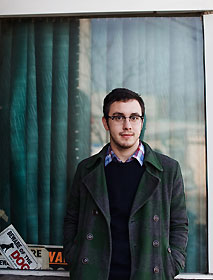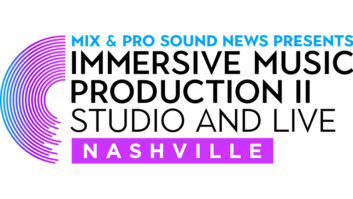
Photo: Vanessa Heins
What started out as demos turned into a full-fledged solo album. Tokyo Police Club keyboardist Graham Wright has always had songs percolating in his brain—even before TPC was formed—and he finally got his chance. Working again with TPC engineers Jay Sadlow and Dean Marino, Wright snatched whatever free time he had (and cash, as he was self-funding this project) and headed into Chemical Sound (Toronto), Sadlow and Marino’s studio. “I basically started recording songs with Dean and Jay in the beginning of 2009, but I thought I was making demos,” Wright recalls. “I had written a bunch of songs and I wanted to do something with them. We recorded two songs each day, and when I sent [the demos] to my manager, he said, ‘They sound like you’re making proper recordings.’ So from them on, it became more [a full album].”
With all three playing instruments, Sadlow and Marino focused more on the music and less on engineering techniques. “Instead,” Sadlow says, “we’d use performance and arrangement to create interest. We doubled horn parts with distorted guitars, we doubled keyboard parts with chromatic bells. If we had an impulse to try a part, we would usually grab the nearest microphone and hit Record. We tried to keep things moving pretty fast because we favored energy over all else.”

Adds Marino, “This album was all about spontaneity and having fun, and I think you can definitely hear that.” Wright concurs: “I’m so glad we started off not knowing what we were doing because I think it really defined the approach that we took, which was a very light touch and ‘let’s live in the moment.’” Shirts Vs. Skins is now available.
Graham Wright on having a different approach than making albums with Tokyo Police Club…
Yes, very much so and I think it was also a reaction to that. Tokyo Police Club writes and records in an extremely pain-stackingly perfectionist manner. I like that we do it, and I think the results speak for themselves. What’s fun about music, for me, is the moment where the spark happens and the creativity hits that one perfect spot. When you’re working on getting everything perfect, those moments come and go and you don’t worry about those moments; you worry about getting it right. Day 17 working on the bridge of a song, it gets kinda old. For me, I became, almost to a fault, obsessed with when a moment came, getting the moment and moving on, to the point where I would force myself to not go back and correct certain things that bothered me. I didn’t want to go down that path; I wanted it to be about capturing moments and having it be raw.
I originally wanted to record it live off the floor and zero things on this record are live off of the floor. But there was this sense that I wanted to capture what happened, even though there wasn’t a band playing. It was three guys in a studio creating that way. And I think it’s just as valid as a band playing off of the floor and I think it’s possible to capture that.
Wright on working with engineers Jay Sadlow and Dean Marino…
Amazing. We’re all on the same page when we’re in the studio. There was never any moment of conflict; it was very open. I always read about people who do improvisational comedy and the number one rule when you’re doing improve is always “yes”; you never want to shut anything down. Whatever happens, you go with it. That’s very much how we work in the studio: No matter how crazy an idea seems, there’s never a thought of shooting it down. It was 10 hours of us locked in a studio, throwing instruments and microphones around and recording whatever idea we had. It was such a blast; I didn’t think it could be this much fun to record.
Sadlow and Marino on their studio, Chemical Sound (Toronto)
It’s not a typical studio in that it’s a bit
like a workshop, but we have world-class gear like a vintage API
Console (circa 1971), EMT plate reverb, MCI JH 24 tape machine,
vintage RCA ribbon mics and first-generation AKG and Neumann condenser
mics. Our live room is large with 30-foot ceilings, a stairwell leading to
a mezzanine and a large skylight. We have a lot of space and you can
hear it on our recordings. There’s enough volume in the room for the
sound of most instruments (even drums) to naturally dissipate, which
is nice. Our control room is isolated from the live room.
On miking techniques…
Sadlow: A lot of the drum tracks were done using a single microphone in the room. We used our 2-track Studer A-80 or our Tascam cassette deck
for echo, and our EMT plate or AKG spring for reverb. I like using the cassette for a distorted slap-back. Usually we print these effects on separate tracks alongside the “dry” stuff.
Marino: I remember using our vintage Nuemann U87 (circa 1970) for most
of the drum tracking and vocal takes. On drums, it was a “whole kit” mic. Sometimes we added an SM57 on the snare and a vintage AKG D12 (not the D112) in the kick drum. When doing vocals, we usually use the U87 in figure-8 pattern because it adds some subtle ambience and reduces proximity effect. We used the Coles 4038 ribbon mic on acoustic guitars.







